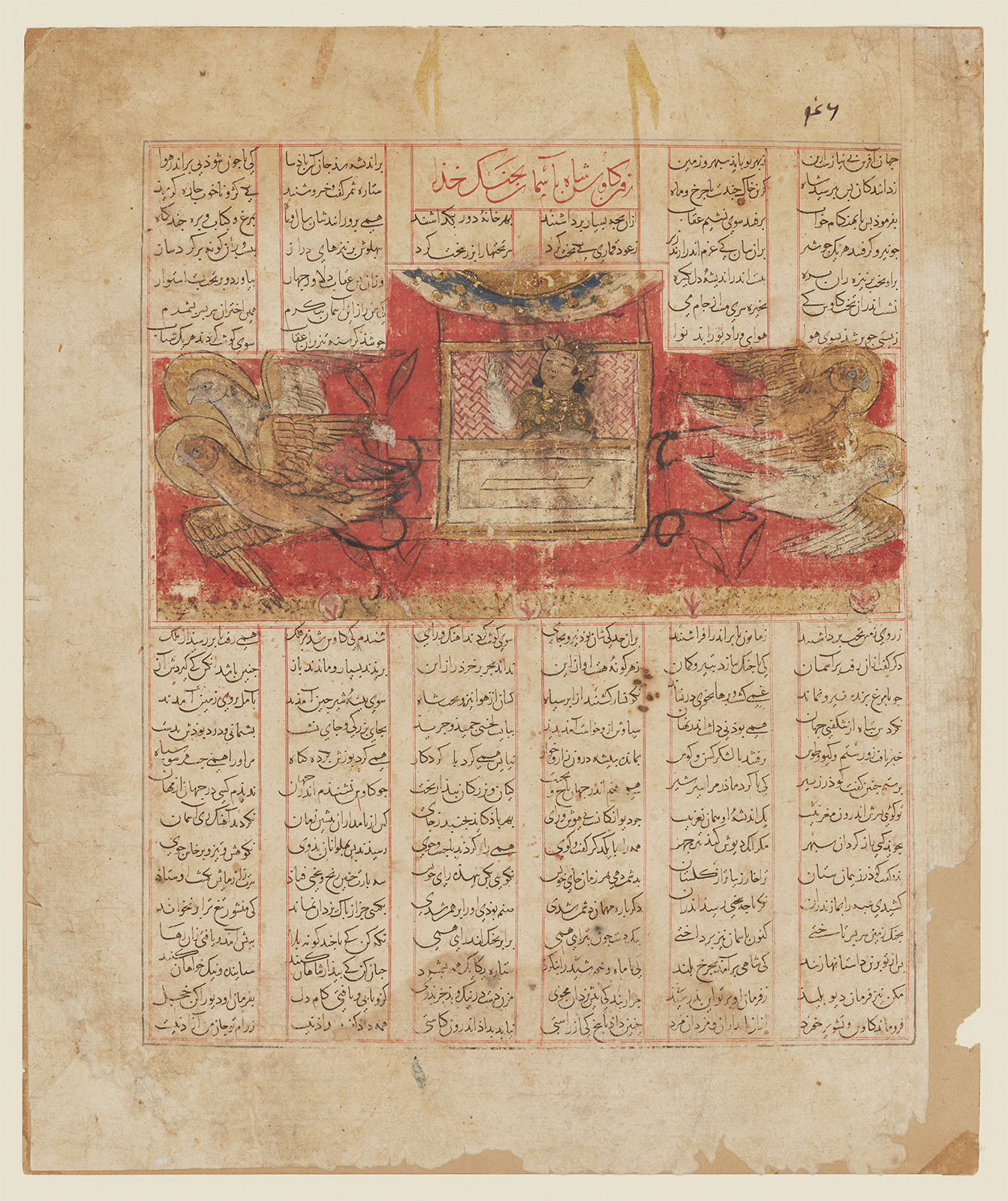Click on the image to zoom
Kay Kavus airborne
Folio from a dispersed copy of Firdausi’s Shahnameh (Book of Kings)
- Accession Number:AKM30
- Place:Iran, Shiraz
- Dimensions:36.4 x 30.4 cm
- Date:741 AH / 1341
- Materials and Technique:Ink, coloured pigments and gold on paper
The Shahnameh (Book of Kings), an epic poem completed in the early 11th century by Firdausi (c.935–1020), recounts the story of Iran through the reigns of 50 kings who ruled from before the dawn of time through the mid-7th century AD. Most of these monarchs were wise and endowed with farr or divine glory. Others—such as the legendary king Kay Kavus, who ruled for 150 years—were filled with hubris and favoured their own interests ahead of the prosperity and security of their kingdom. Kay Kavus’s reign was marked with many royal misadventures, including an attempt to conquer the neighbouring country of Mazandaran that resulted in his capture by a troop of demons. Kay Kavus also fell prey to malevolent and perfidious influences. AKM30 (folio 46 recto) from a dispersed copy of the Shahnameh completed in 1341 presents such an episode.
Further Reading
Disguised as a comely young man, a demon caught Kay Kavus’ attention by offering him a bouquet of flowers during a hunting excursion. The demon then persuaded Kavus that one way to insure his perpetual glory would be to rise up to the heavens and thereby learn the secrets of the heavenly sphere—something that no other monarch had ever achieved. Realizing that such a feat would require wings, Kavus ordered his men to rob eagles’ nests and to rear the squabs, or baby eagles, on poultry and meat. When the eagles had grown large and strong, Kavus ordered a throne with a lance at each of its four corners to be built of wood and gold. Meat was suspended from these lances and four eagles were lashed onto the structure. Then Kay Kavus sat on the throne, and as the eagles grew hungry and flew toward the suspended meat, the throne was lifted off the ground. It continued to rise as the hungry birds beat their wings desperate to reach food. Finally, the birds’ strength waned, and they tumbled back to earth, where the throne came to rest in a thicket. Miraculously, Kay Kavus was unscathed in the fall. He was immediately filled with humiliation and regret for his foolishness.
The illustration to this extraordinary episode in AKM30 (folio 46 recto) from the 1341 Shahnameh has become abraded over the centuries. Nonetheless, it is still possible to make out the youthful Kay Kavus in the centre, crowned and seated in what looks like the basket of a hot-air balloon. The king raises his right arm and index finger to point up at the semi-circular rings above, which represent the golden sun, the blue sky, and the twinkling stars. The four large eagles fly out in horizontal formation from the basket’s sides, pulling the throne with long, black leads. The composition does not, however, depict the meat intended to lure the birds skyward. The anonymous artist of this scene did, however, surround the birds’ heads with what look like golden halos to set them off from the red background. He also added a strip of ochre-coloured blades of grass and sketchy plants as a groundline to indicate that Kay Kavus has not yet “flown” very high above the ground.
— Marianna Shreve Simpson
Note: This online resource is reviewed and updated on an ongoing basis. We are committed to improving this information and will revise and update knowledge about this object as it becomes available.


